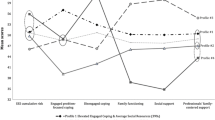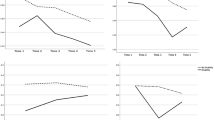Abstract
Mothers and fathers of 125 handicapped/chronically ill children were compared with parents of 127 matched nondisabled children from three separate samples with respect to personal stress, marital satisfaction, and social network size and density. Only mothers of disabled children experienced higher levels of stress than comparison parents. No differences were found in marital satisfaction. Few group differences were found for social network variables, although mothers of handicapped children had higher-density networks than comparison mothers. A series of ANOVAs examined differences among the three types of families of handicapped children. Significant differences among the groups were found for social network but not family stress variables. The results are discussed in terms of general differences between families with and without a disabled child, and point to the need to identify patterns within different types of family systems in conducting future research in this area.
Similar content being viewed by others
References
Billings, A., & Moos, R. (1984). Coping, stress and social resources among adults with unipolar depression.Journal of Personality and Social Psychology, 96, 877–891.
Bronfenbrenner, U. (1979).The ecology of human development. Cambridge, Massachusetts: Harvard University Press.
Crnic, K., Friedrich, W., & Greenberg, M. (1983). Adaptation of families with mentally retarded children: A model of stress, coping, and family ecology.American Journal of Mental Deficiency, 88, 125–138.
Cummings, S. (1976). The impact of the child's deficiency on the father: The study of fathers of mentally retarded and chronically ill children.American Journal of Orthopsychiatry, 46, 246–255.
Cummings, S., Bayley, H., & Rie, H. (1966). Effects of the child's deficiency on the mother: A study of mothers of mentally retarded, chronically ill, and neurotic children.American Journal of Orthopsychiatry, 36, 595–608.
Dohrenwend, B., Shrout, P., Egri, G., & Mendelson, F. (1980). Nonspecific psychological distress and other dimensions of psychopathology.Archives of General Psychiatry, 37, 1129–1238.
Eiser, C. (1985).The psychology of childhood illness. New York: Springer-Verlag.
Friedrich, W., Wilturner, L., & Cohen D. (1985). Coping resources and parenting mentally retarded children.American Journal of Mental Deficiency, 90, 130–139.
George, L., & Beacon, L. (1980).Quality of life in older persons: Meaning and measurement. New York: Human Services Press.
Hill, R. (1958). Generic features of families under stress.Social Casework, 49, 139–150.
Hirsch, B. (1979). Psychological dimensions of social networks A multidimensional analysis.American Journal of Community Psychology, 7, 263–277.
Hirsch, B. (1980). Natural support systems and coping with major life change.American Journal of Community Psychology, 8, 159–172.
Holroyd, J. (1974). The questionnaire on resources and stress: An instrument to measure family response to a handicapped family member.American Journal of Community Psychology, 2, 92–94.
Jones, L., & Fischer, C. (1978).Studying egocentric networks by mass survey (Working paper 234). Berkeley: University of California, Institute of Urban and Regional Development.
Kazak, A., & Clark, M. (1986). Stress in families with myelomeningocele.Developmental Medicine and Child Neurology, 28, 220–228.
Kazak, A., & Marvin, R. (1984). Differences, difficulties, and adaptation: Stress and social networks in families with a handicapped child.Family Relations, 33, 67–77.
Kazak, A., & Wilcox, B. (1984). The structure and function of social networks in families with handicapped children.American Journal of Community Psychology, 12, 645–661.
Langner, T. (1962). A 22 item screening score of psychiatric symptoms indicating impairment.Journal of Health and Human Behavior, 3, 269–276.
McAlister, R., Butler, E., & Lei, R. (1973). Patterns of social interaction among families of behaviorally retarded children.Journal of Marriage and the Family, 35, 93–100.
McAndrew, I. (1976). Children with a handicap and their families.Child: Care, Health and Development, 2, 213–237.
Mitchell, R., & Trickett, E. (1980). Social networks as mediators of social support: An analysis of the effects and determinants of social networks.Community Mental Health Journal, 16, 27–44.
Sabbeth, R., & Leventhal, J. (1984). Marital adjustment to chronic childhood illness: A critique of the literature.Pediatrics, 73, 762–768.
Sharpley, C., & Cross, D. (1982). A psychometric evaluation of the Spanier Dyadic Adjustment Scale.Journal of Marriage and the Family, 38, 15–28.
Silbert, A., Newburger, J., & Fyler, D. (1982). Marital instability and congenital heart disease.Pediatrics, 69, 747–750.
Spanier, G. (1976). Measuring dyadic adjustment: Scales for assessing the quality of marriage and other dyads.Journal of Marriage and the Family, 38, 15–28.
Spanier, G., & Thompson, L. (1982). A confirmatory analysis of the Dyadic Adjustment Scale.Journal of Marriage and the Family, 44, 731–738.
Stein, R., & Jessop, D. (1982). A non-categorical approach to chronic childhood illness.Public Health Reports, 97, 361–378.
Townsend, P., & Flanagan, J. (1976). Experimental preadmission program to encourage home care for severely and profoundly retarded children.American Journal of Mental Deficiency, 80, 562–569.
Waisbren, S. (1980). Parents' reactions to the birth of a developmentally disabled child.American Journal of Mental Deficiency, 84, 345–351.
Wilcox, B. (1981). The role of social support in adjustment to marital disruption: A social network analysis. In B. Gottlieb (Ed.),Social networks and social support in community mental health (pp. 97–115). Beverly Hills: Sage.
Wright, L., Schaeffer, A., & Solomons, G. (1979).Encyclopedia of pediatric psychology. Baltimore: University Park Press.
Author information
Authors and Affiliations
Additional information
Portions of this paper were presented to the annual meeting of the National Council on Family Relations, Family and Health Section, November 1985, Dallas. This research was supported, in part, by grants from the Temple University Biomedical Research Support Program and the Temple University Grant in Aid of Faculty Research. The author wishes to thank staff and participants from St. Christopher's Hospital for Children, Philadelphia, PA, The Children's Rehabilitation Center of the University of Virginia Medical Center, Charlottesville, VA, and The Woodhaven Center, Philadelphia, PA.
Rights and permissions
About this article
Cite this article
Kazak, A.E. Families with disabled children: Stress and social networks in three samples. J Abnorm Child Psychol 15, 137–146 (1987). https://doi.org/10.1007/BF00916471
Revised:
Issue Date:
DOI: https://doi.org/10.1007/BF00916471




